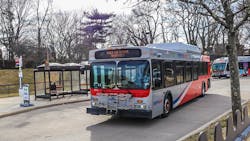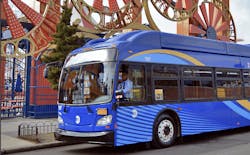The Washington Metropolitan Area Transit Authority (WMATA) and the Metropolitan Transportation Authority (MTA) launched their Better Bus Network redesigns on June 29.
WMATA’s Better Bus Network to help provide service across Washington, D.C., Maryland and Virginia
WMATA’s Better Bus Network is the agency’s first comprehensive overhaul of the Metrobus system since 1973. WMATA notes the initiative will deliver more frequent, reliable and user-friendly bus service to communities across Washington, D.C., Maryland and Virginia, aligning with the region’s evolving travel needs.
The newly redesigned bus network introduces a modernized bus system designed to make trips faster, reduce transfers and simplify schedules. Under the redesign, Metrobus routes will feature new, intuitive names – such as “C” for crosstown D.C., “P” for Prince George’s County or “A” for Arlington/Alexandria – making it easier for riders to navigate. WMATA says many routes will offer enhanced service, with updated schedules, new destinations and approximately five percent fewer stops to improve speed and reliability. Customers will also see better connections to schools, workplaces and key destinations, including tailored routes for Washington D.C., students. Metrobus fares remain unchanged at $2.25.
“This is a historic moment for [WMATA] and our region,” said WMATA General Manager and CEO Randy Clarke. “The new network reflects years of community input and careful planning to create a bus system that’s more reliable, more accessible, and ready for the future.”
According to WMATA, the redesign also coordinates with regional partners. In Prince George’s County, Md., TheBus launched its new network on June 30, with some routes transitioning between WMATA and TheBus for seamless service. In Montgomery County, Md., Ride On’s new network began June 29, enhancing connectivity.
“Redesigning a bus network of this size without a budget increase requires creativity, technical expertise and commitment to operational efficiency,” said WMATA Board Chair Valerie Santos. “The board appreciates the immense thought and care [WMATA] staff have invested in this complex endeavor. Guided by the insights of over 21,000 public comments, [WMATA’s] new modernized bus network is designed to bring much-needed service to previously underserved areas and uphold [WMATA’s] commitment to delivering safe, reliable and world-class transit service to our region.”
WMATA says new bus stop signs, featuring both current and upcoming route information, are being installed across the region, with supplemental signs providing additional resources like WMATA’s website and customer service number.
The agency notes riders can get familiar with their new bus route in various ways:
- Trip Planner: Customers are encouraged to use the agency’s Trip Planner tool or the MetroPulse app to navigate the new bus network.
- Neighborhood and route profiles: Riders can see which Metrobus routes service their neighborhood and find multilingual resources and detailed route maps for Washington, D.C., Maryland and Virginia on WMATA’s website.
- Printable timetables: A new tool also gives customers the ability to print their own personalized bus timetable.
MTA begins Phase 1 of Queens Bus Network Redesign
Phase 1 of the MTA’s Queens Bus Network Redesign marks the beginning of the most significant transformation of the borough’s bus system in more than half a century.
MTA notes Phase 1 implements approximately 70 percent of the changes and the remaining set of changes will roll out in Phase 2, which begins Aug. 31.
“There are literally hundreds of MTA ambassadors out today, making sure that everybody in Queens knows, especially eastern Queens, where the changes are in effect right now, that many bus routes have changed,” said MTA Chair and CEO Janno Lieber. “Now, the good news is there's more service. We have 11 more bus routes than we did before. We're spending $35 million more a year to give Queens better, faster bus service. We spent five years listening to Queens and making changes, so people could get more service and better service, and we're rolling it out right now.”
According to the MTA, with an additional $33.7 million invested annually in bus operations to maintain service levels introduced in the redesign, the agency is delivering on its commitment to prioritize better bus service and bring long overdue improvements to the city’s most bus-dependent borough.
The Queens Bus Network Redesign is part of major effort to modernize New York City’s bus network across every borough. The agency says that over decades, demographics have shifted in residential and business communities and so have travel patterns. The redesigned networks aims to deliver the needed larger-scale improvements to better meet the demand of current and future bus customers.
In 2018, a redesigned express bus network was implemented on Staten Island. In 2022, a redesigned local bus network was implemented in the Bronx. In Brooklyn, the project team is reviewing feedback from the Brooklyn Bus Network Redesign’s Draft Plan that was released in December 2022 to develop the Proposed Final Plan. The agency notes Manhattan will be the last of the boroughs to begin its bus network redesign, to be followed by the Staten Island Local and Bronx Express bus network redesigns at a later date.
About the Author
Brandon Lewis
Associate Editor
Brandon Lewis is a recent graduate of Kent State University with a bachelor’s degree in journalism. Lewis is a former freelance editorial assistant at Vehicle Service Pros in Endeavor Business Media’s Vehicle Repair Group. Lewis brings his knowledge of web managing, copyediting and SEO practices to Mass Transit magazine as an associate editor. He is also a co-host of the Infrastructure Technology Podcast.


